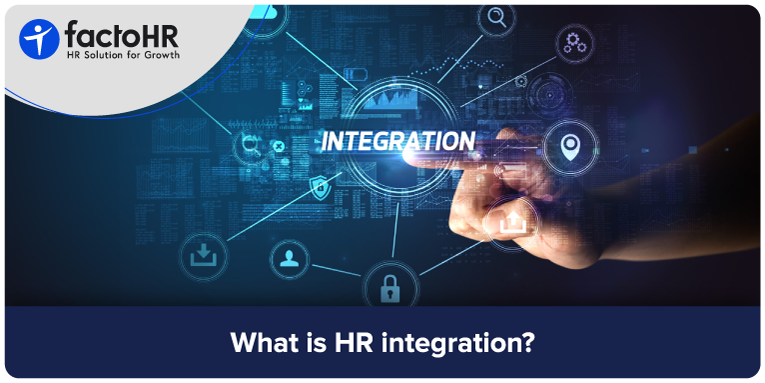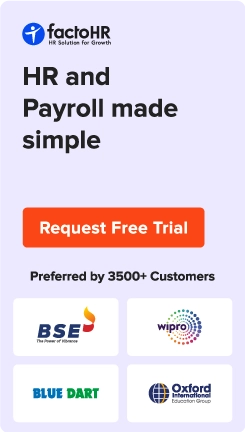What is HR Integration? Benefits, Types, & Best Practice

Table of Contents
HR integration has become increasingly important in modern businesses for enhanced operational efficiency in recent years. By integrating HR software with other business tools, organizations set the stage for complete automation. It improves data flow, eliminating manual inputs during performance appraisals and onboarding.
The benefits of HR integration include higher precision and time savings. However, HR integration also has several challenges. This is why this blog discusses the definitions, types, benefits, and possible difficulties of HR integration.
What is HR Integration?
HR integration is a process that aims to centralize all HR functions through a continuous and simplified flow of information. All essential HR systems like payroll, attendance, leave, and performance must be linked to facilitate an easy transfer of data, whether third-party or on-premise.The primary benefit of doing so is easy accessibility to all the necessary details that help increase efficiency of business operations and avoid errors caused by manual processes.

Why are HR Software Integrations Important for Your Company?
HR software integrations are essential in automating the majority of HR tasks, which makes operations smoother and more consistent in the human resource department. It helps save costs and effectively processes HR operations such as payroll, benefits, and recruitment. Further, consolidating all the data in one place would make analytics possible. It could help organizations uncover trends in the workforce. Then, it paves the way for making informed decisions that complement the company’s goals.
Having error-free data and records is very important while making critical decisions. Such integrated systems reduce manual entry and increase data security and efficiency. Such systems become vital for HR functions as they support generating reports and analysis to focus on strategic initiatives, enhance the employee experience, and foster collaboration across departments.
How does HR Integration Work?
Integration in human resource management involves effortlessly linking diverse HR functions, data, and processes in an organization with overall business objectives. Manual HR operations seem time-consuming, but HR software integration automates effective organizational operations by consuming less time.
Because of rapid developments in HR software, the integration process has grown complex. Gone are the days when we used a separate tool for every task; full-fledged HR suites nowadays work online. This integration improves productivity and retention and synchronizes HR activities like payroll, performance, and talent management with business objectives.
For example, managers can use performance management software integrated with the HRMS to set development targets and provide real-time feedback, enhancing employee productivity and retention.
As businesses evolve, integrated HR processes become imperative for simplifying tasks and aligning the correct data across departments. Thus, HR integration has become more common and critical in recent business trends.
How are HR Software and Integration Evolving?
HR software and its integration are rapidly evolving based on business trends and requirements to sustain and compete in the business world. Integration brings all HR functions together to support payroll, benefits, and everything else as needed.
Major Benefits:
- Mobility: Employees manage their HR needs anywhere to transition seamlessly through mergers.
- Flexibility: Integrated systems can quickly adapt to the organization’s changes.
- Better Informed Decision Making: HR can use real-time data to improve speed or fairness in decision-making, for example, in compensation or benefits.

Types of HR Software Integrations
API Integrations
API Integrations allow data to flow from HR software to other tools, like payroll systems, in real time. Information updated in the HR system about employees automatically shows up in the payroll, saving time and frustration due to fewer manual errors.
Pre-Built Integrations
Pre-built Integrations offer connections provided by software developers. Hence, HR software can be used to connect with other popular applications. It connects with Microsoft Office or Google Workspace without technical expertise, making things easy.
Custom Integrations
Custom Integrations by software developers offer tailored HR integration based on an organization’s requirements. Features modified to a company’s needs take time and money in comparison with the pre-built ones.
Cloud vs. On-Premise Integrations
Cloud integration gives you remote access to the data, while on-premise integration secures data and limits it to one location. These two integration types have their strengths and weaknesses. Cloud integration is flexible and convenient; it can be accessed anywhere, anytime. On-premise integration is very secure, but also costly and tedious.
File-Based Integrations
It involves importing and exporting data files, such as spreadsheets. It is helpful for simple transfer needs but requires human work to verify data integrity.
Recruitment
PwC’s 2024 HR Technology Survey shows that about 65% of companies leverage HR technology to find and retain employees. This increased adoption streamlines routine administrative tasks and frees up valuable time for HR teams. As a result, HR professionals can focus on making more brilliant, strategic recruiting decisions.
Employee Attendance Management
HR integration in employee attendance management automates pay calculations with payroll process management. Pay calculations are calculated using an employee’s attendance records, which include the number of hours worked, leaves, and overtime.
Health and Safety
Integrating health and safety in human resource management involves incorporating employee safety rules into HR practices and establishing continuous employee safety training. These measures create a positive workplace and a better organization.
Talent Management
Talent management in HR integration unites recruitment, training, and performance management with business strategy. The overall vision of talent management processes is to leverage strategies to attract, develop, and retain desired people by conducting data—and evidence-based analyses of employees.
This integration uses talent management systems (TMSs) that allow centralized data storage covering an organization’s entire talent lifecycle. This makes it easier to equip employees individually with the needed skill development and inclusiveness, thereby increasing efficiency.

What are the Key Benefits of HR Integration?
HR integration is crucial for streamlining HR workflows. Linking various HR functions increases data accuracy and enhances organizational effectiveness. Some critical key benefits are listed below.
No Double Data Entry
Eliminate redundancies and minimize errors to maximize efficiency and improve data integrity to automate calculations based on the system records.
Higher Data Consistency and Accuracy
HR integration guarantees accurate employee information across the systems, facilitating decision-making and improving compliance.
Makes HR Operations Easier
HR integration combines HRM functions and minimizes the admin burden, allowing for efficiency and a great employee experience.
Real-Time Data Availability
Human resource integration allows immediate access to employee data, resulting in confident decision-making and increased employee engagement.
Employee Well-Being
It enables HR professionals to concentrate on employee health through wellness initiatives with increased productivity and satisfaction.
A One-Stop Shop for Data
HR integration benefits efficiency in decision-making and countering implementation triumphs. An interactive dashboard will provide visual insights that make it easier to read and analyse.
Compliance with Regulations
HRM integration guarantees compliance with laws and policies, significantly reducing legal risks and improving accuracy. Organizations need to know how to solve complex regulations. Setting up an observant HR team for compliance will help you ensure that the ongoing laws in the region are adhered to properly.
Mobile Access
HR integration enhances mobile access to monitor and manage HR functions. Using a mobile interface for HR services is convenient for HR professionals and creates better engagement.
Scalability of Software
HR systems can be adjusted according to changing needs without compromising performance. Based on business requirements, organizations can scale. They can opt for vertical or horizontal scaling, which is appropriate for their needs.

Examples of HR Integration
Payroll Integration
Payroll Integration automates employee compensation management through cross-platform data sync so that hours, overtime, and bonuses are accurately tracked. This reduces the risk of manual entry errors while ensuring tax compliance. Payroll integration enables HR teams to focus more on strategic initiatives, increasing employee satisfaction.
Attendance & Time Tracking Integration
Attendance and Time Tracking Integration gathers real-time employee data to facilitate accurate reports of hours worked and absenteeism. This syncs with payroll systems to automate pay calculations, reduce discrepancies, and ensure timely employee compensation.
Performance Management Integration
Performance Management Integration links goal-setting, feedback, and appraisal systems to continuously track employee progress. This integration enables a continuous performance dialogue, fosters employee development, and instills a performance culture that enhances engagement and retention.
Recruitment & ATS Integration
Recruitment and ATS Integration ensures a smooth hiring process by centralizing candidate information for better sourcing, screening, and communication. Functions such as resume parsing and interview scheduling alleviate administrative load, enhance the candidate experience, and attract the best talent.
Learning Management System (LMS) Integration
LMS Integration enables effective employee training management by coordinating learning paths and tracking compliance. It identifies skill gaps and measures training effectiveness, nurturing a culture of continuous improvements where employees access necessary resources for their growth.
Benefits & Compensation Integration
Benefits and Compensation Integration eases employee benefits and compensation management by interlinking HR functions. Thus, it streamlines open enrollment, tracks participation, enlightens employees about their entitlements, and works toward regulating compliance.
Communication & Collaboration Tools Integration
Integrating HR software with communication tools and collaboration software leads to higher organizational connectivity. It enhances team engagement and effective performance.
Compliance & Legal Integration
Compliance and Legal Integration give HR professionals the tools to follow labor laws. These tools automate documentation and securely manage employees’ records, reducing compliance risk and making employees feel secure about their rights.
Employee Self-Service Portal Integration
Employee Self-Service Portal Integration will empower employees to administer their HR matters, easing the HR workload while boosting employee experience. An efficient process allows easy access to critical information and enhances satisfaction.
Cloud Storage & Document Management Integration
Cloud Storage and Document Management Integration allow employee records to be stored safely, efficiently, and securely in the cloud.

9 Challenges Faced in HR Integration
HR integration is fraught with its own set of nine challenges.
1. Budgetary Constraints
Budgetary constraints have remained an essential challenge in the HR integration environment. HR funding for technology or software upgrades is limited, restricting software options and stifling innovation. Organizations can concentrate on the most critical capabilities and seek a scalable modular system for integration within their budget limit.
2. Lack of Standardised Technology
If you have an existing system and want to add a payroll service, the system may fail if the new service does not integrate properly. The existing data may be lost at that moment, making payroll processing difficult. Due to the lack of standardised technology, proper HR integration is hard to achieve.
3. Connecting with the Business
One of the core issues in most Human Resource (HR) departments is the misalignment of its objectives with the overall business strategy. It makes collaboration difficult for other teams. Creating effective communication channels across all core HR functions will improve cooperation and solidify HR’s role as a genuine business partner.
4. Integration Can be Costly
Integrating an HR software system with proper licensing and a premium subscription can be expensive. Several hidden costs may spring up and further burden the finances. Before proceeding with the integration, organizations should perform cost-benefit analyses and explore possible scalable solutions for progressive investment.
5. Regular Maintenance Might be Tough
Ongoing updates and maintenance of human resources integration systems may present a considerable inconvenience to human resources departments. It requires substantial IT assistance and resources now and then. Organizations that fail to invest adequate time and resources in maintenance can anticipate severe operational disruptions and inefficiencies, resulting in breakdowns, errors, and heightened frustration among employees.
6. Data Compatibility
Ensuring that compatible data across systems is an essential component of HR integration. Various software may have different data formats, making data transfer challenging. Organizations should evaluate data formats pre-integration and invest wisely in data cleaning to facilitate seamless exchange.
7. the Team May be Reluctant to Change
Resistance to change is often a problem in HR integration. Employees who are used to the existing practices find adapting to the new system hard.
8. Ensuring a Positive User Experience
Positive user experience is imperative for the success of every integrated HR system. If it is not easy to use, the system will frustrate end-users and decrease productivity. Organizations should emphasize the user-friendly interface and on-site training to ensure comfort with the system.
9. Data Entry Errors
Manual data entry inaccuracies impede the integration of Human Resources, despite the availability of accurate employee information. Automated data validation tools and regular audits can thus improve the accuracy and safety of data integrity.

Best Practices for HR Integration
Data Security
Employees’ essential and sensitive information must be kept safe during HR integration. A suitable data security protocol should be established to be compliant and protect against breaches. Encryption techniques should be used to secure data, and multi-factor authentication should be implemented to restrict access. A clear data governance policy allows for data gathering, which seems to be best practice for HR integration. Regular audits shall identify vulnerabilities to improve and enhance protection.
Inclusive Plan
An integrated HR model has an organized plan containing the phases for each process and sets the timeline, people, and resources responsible for the implementation. Important milestones are established for tracking evidence and accountability. A needs analysis is included in the plan to identify gaps and opportunities. Additionally, the plan should address potential risks that could hinder the process and outline strategies for managing these risks in alignment with business objectives.
Objectives of Integration
Strongly defined integration goals need proper establishment as they lead to success. Integration objectives have to be specific and strategic, which supports meeting business requirements. Setting specific, measurable, achievable, realistic, time-bound goals (SMART) allows organizations to focus on effort without wasting time changing things, at least now and then, to catch up with new needs.
Assess System Compatibility
Before integration, it is necessary to evaluate the compatibility of all the Human Resources Systems. Organizations should review their data formats and user interfaces to identify potential future issues. Involving IT experts during a systems assessment helps determine necessary adjustments and minimizes disruptions during integration.
Engage Stakeholders
Get key stakeholders involved so executives, IT, and employees realize the support. Elicit open communication and gather feedback to enhance buy-in. A culture of cooperation nurtures trust and commitment among stakeholders for cohesive integration efforts.
Training and Support
Provide comprehensive training for HR staff on using the new integrated systems efficiently. For example, conduct hands-on seminars to familiarize HR administrators with the software’s functionality and offer user guides and tutorials for ongoing support.

Conclusion
HR integration is, in fact, one of the most significant advancements in human resource management, making organizations increasingly effective and efficient. Flowing data eases all administrative work and augments the chances of an even more engaged and productive workforce.
In this ever-evolving world of business, companies are integrating different systems, and in that process, they uncover many challenges and possibilities ahead. Indeed, HR integration is beneficial in many ways, but the most productive is raising an organization’s performance levels and allowing companies to sustain themselves in a competitive marketplace.
What is the Integrated Approach in HR?
The integration approach in HR combines the functions of hiring, organizing, and employee engagement into one system.
What is Vertical Integration in HR?
Vertical HR integration will improve team workflows by automating processes and allowing HR professionals to focus on strategic objectives rather than administrative responsibilities.
How Will the Integration Affect Certain HR Procedures and Functions, and How Will They Change?
The HR integration affects certain HR activities, such as recruitment, onboarding, and payroll management, which will become more efficient, thanks to enhanced openness and accuracy.
What’s an Example of Integrated Human Resources?
Managers use performance-tracking software integrated with the HR system to deliver real-time feedback and establish development objectives, increasing employee retention and productivity.
Grow your business with factoHR today
Focus on the significant decision-making tasks, transfer all your common repetitive HR tasks to factoHR and see the things falling into their place.

© 2025 Copyright factoHR


